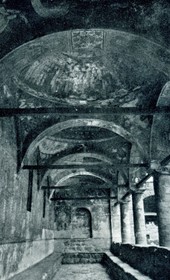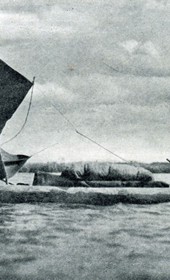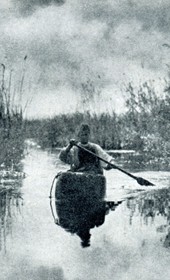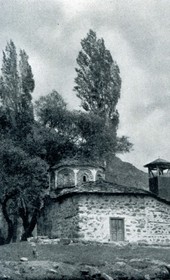| | Robert Elsie | AL Art | AL History | AL Language | AL Literature | AL Photography | Contact | |
Robert Elsie
Early Photography in Albania
BACK | AL Photography
The Photo Collection
of Hugo Bernatzik
Deutsch | ShqipAlbania in 1929
The Austrian anthropologist, photographer and travel writer, Hugo Adolf Bernatzik (1897-1953), was born in Vienna as the son of Edmund Bernatzik (1854-1919), professor of law at the University of Vienna. As an adolescent before the First World War, he was in contact with Albanians in Constantinople, in particular with the sons of the sultan’s personal bodyguard, and had an opportunity to visit Albania in 1914 during the ephemeral reign of Prince Wilhelm zu Wied (1876-1945). In 1915, during the war, he volunteered for military service with an artillery regiment of the Austro-Hungarian army and in December 1917, having been promoted to the rank of a lieutenant, was sent once again to Albania. The marshy landscape of the Albanian coastline appealed to him because of his interests in nature and bird-watching, and it caused him to want to return there in later years. Having abandoned the study of medicine, he went into business in Vienna after the war, but was motivated primarily by adventure which he sought in travel. Between 1923 and 1930, he was in Africa four times (the Maghreb, Egypt, southern Sudan, Somalia), in 1932-1933 in the South Pacific and New Guinea, in 1936-1937 in southeast Asia, and in 1938 in Lapland. Most of these trips resulted in ethnographic studies or travel books and splendid photographs. He financed his journeys by selling his photographs to newspapers and magazines. In 1930 he began studying ethnology, psychology and geography at the University of Vienna, where he finished a doctorate in 1932, and in 1939 he was professor of ethnology at the University of Graz. Bernatzik is remembered as a promoter of alternative anthropology and became one of the best known German-language anthropologists of the 1930s. After the Second World War, during which he had been a member of the NSDAP (Nazi) party, he travelled to Morocco (1949-1950), but fell ill with a tropical infection, and died in Vienna of the complications thereof. In Vienna (Döbling) there is now a street, Bernatzikgasse, that is named after him.
Hugo Bernatzik’s main expedition to Albania took place from 24 April to 6 July 1929, following a trip to the Danube delta in Romania to study bird life there. For the Albanian trip, he was initially assisted with information by geologist Ernst Nowack (1891-1946), who recommended that he contact the German envoy in Tirana, Franz von Scheiger (1891-1960). Equipped with a tent, kayak and camera, Bernatzik was also in contact with landowner Ago Agaj (1897-1994), with whom he went bird hunting on the plain of Myzeqeja. The Albanian expedition resulted in two book publications: Riesenpelikane und ihre Kinder (Giant Pelicans and their Children), Vienna 1930, a small and rather obscure bird album about the pelican colonies in the Maliq marsh near Korça; and Europas vergessenes Land (Europe’s Forgotten Land), Vienna 1930, republished in an expanded edition under the title: Albanien: das Land der Schkipetaren (Albania: the Land of the Shkiptars), Vienna 1939. The present collection derives from the latter edition.
Die Fotosammlung des Hugo Bernatzik
English | ShqipAlbanien im Jahre 1929
Der österreichische Ethnologe, Fotograf und Reiseschriftsteller, Hugo Adolf Bernatzik (1897-1953) wurde in Wien als Sohn des Staatsrechtlers Edmund Bernatzik (1854-1919) geboren. Schon vor dem Ersten Weltkrieg in Konstantinopel fanden seine ersten Kontakte mit Albanern statt, insbesondere mit den Söhnen der Leibgarde des Sultans. Während der kurzen Herrschaft des Fürsten Wilhelm zu Wied (1876-1945) besuchte er Albanien zum ersten Mal 1914. Im Jahre 1915 ging er mit einem Artillerieregiment als Freiwilliger in den k.u.k. Kriegsdienst und wurde nach Albanien versetzt. Im Dezember 1917 wurde er als Leutnant nochmals nach Albanien entsandt. Die sumpfige Landschaft der albanischen Küste reizte ihn besonders, da er sich für Natur und Vögel interessierte. Ein Medizinstudium an der Universität Wien brach er ab und ging in die Privatwirtschaft, aber sein Hauptinteresse galt Reisen und Abenteuer. In den folgenden Jahren war er zwischen 1923 und 1930 viermal in Afrika (Nordafrika, Ägypten, Südsudan, Somaliland), später dann im Südpazifik und Neuguinea (1932-1933), Südostasien (1936-1937), und Lappland (1938). Aus diesen Reisen ergaben sich wissenschaftliche Publikationen, Reisebücher und ausgezeichnete Fotografien. Bernatzik finanzierte seine Reisen, indem er seine Fotoaufnahmen an Zeitungen und Zeitschriften verkaufte. Im Jahre 1930 nahm Bernatzik ein Studium der Ethnologie, Psychologie und Geographie an der Universität Wien auf, das er 1932 mit einer Promotion abschloss. Im Jahre 1939 war er Professor an der Universität Graz. Als Verfechter der angewandten Völkerkunde wurde Hugo Bernatzik seinerzeit zu einem der renommiertesten Ethnologen im deutschsprachigen Raum. Nach dem Zweiten Weltkrieg, währenddessen er Mitglied der NSDAP gewesen war, reiste er nach Marokko (1949-1950), wo er an einer Tropeninfektion erkrankte, die später in Wien zu seinem Tode führte. Dort in Döbling (19. Bezirk) gibt es nun eine nach ihm benannte Bernatzikgasse.
Im Anschluss an eine Aufenthalt an der Donaumündung in Rumänien, wo er die artenreiche Vogelwelt studierte, reiste Hugo Bernatzik wieder nach Albanien und hielt sich dort vom 24. April bis zum 6. Juli 1929 auf. Anfängliche Auskunft über die Zustände im Lande hatte er vom Geologen Ernst Nowack (1891-1946) erhalten, der empfahl, dass er sich mit dem deutschen Gesandten in Tirana, Franz von Scheiger (1891-1960), in Verbindung setze. Bernatzik war auch mit dem albanischen Großgrundbesitzer Ago Agaj (1897-1994) in Kontakt, mit dem er in der Myzeqeja-Ebene auf die Vogeljagd ging. Ausgerüstet mit einem Zelt, einem Klepperboot (Kajak) und einem Fotoapparat zog Bernatzik zwei Monate lang durch Albanien. Frucht dieser Expedition waren zwei Bücher: Riesenpelikane und ihre Kinder, Wien 1930, ein kleines Vogelalbum über Pelikane im Sumpfgebiet von Maliq bei Korça, und Europas vergessenes Land, Wien 1930, das in einer erweiterten vierten Auflage mit dem Titel: Albanien: das Land der Schkipetaren, Wien 1939, erschien. Die hier vorgestellten Fotos stammen aus dem letzteren Band.
Koleksioni fotografik i Hugo Bernacikut (Hugo Bernatzik)
English | DeutschShqipëria në vitin 1929
Etnologu, fotografi dhe udhëpërshkruesi austriak, Hugo Adolf Bernacik (1897-1953), lindi në Vjenë, bir i juristit Edmund Bernacik (1854-1919). Kontaktet e para me shqiptarët i pati që para Luftës së Parë Botërore në Stamboll, ku njohu djemtë e rojeve të sulltanit. Hugo Bernaciku shkoi në Shqipëri për herë të pare në vitin 1914 gjatë pushtetit të shkurtër të Princ Vidit (Wilhelm zu Wied, 1876-1945). Në vitin 1915, kur ndodhej përsëri në Shqipëri, shërbeu vullnetar në ushtrinë austro-hungareze me një njësi artilerie. Edhe në dhjetor 1917 ai ishte sërish në tokën shqiptare me gradë togeri. Kënetat e bregdetit shqiptar e tërhoqën shumë sepse interesohej për natyrën dhe për zogjtë. Bernaciku braktisi studimin e mjekësisë në Universitetin e Vjenës sepse preferonte të udhëtonte dhe të zbulonte botën. Gjatë periudhës 1923-1930 shkoi katër herë në Afrikë (Afrika e veriut, Egjipti, Sudani jugor dhe Somalilandi), dhe më vonë në Pacifikun jugor dhe Guinenë e Re (1932-1933), Azinë juglindore (1936-1937) dhe Lapland (1938). Nga këto udhëtimet dolën botime shkencore, udhëpërshkrime dhe fotografi tërheqëse. Bernaciku i financoi udhëtimet e veta duke u shitur fotografi të udhëtimeve gazetave dhe revistave. Në vitin 1930 filloi të studionte etnologji, psikologji dhe gjeografi në Universitetin e Vjenës dhe atje mbaroi doktoraturën në vitin 1932. Në vitin 1939 ishte profesor i Universitetit të Gracit (Graz). Si përkrahës i etnologjisë së aplikuar Hugo Bernacik u bë në atë kohë një ndër etnologët më të spikatur të botës gjermane. Pas Luftës së Dytë Botërore, gjatë së cilës ishte anëtar i partisë naziste, ai udhëtoi në Marok (1949-1950) ku e zuri një sëmundje tropikale, nga e cila vdiq më vonë në Vjenë. Në lagjen 19 të kryeqytetit austriak ekziston një rrugë me emrin e tij, Bernatzikgasse.
Në vijim të një qëndrimit në deltën e lumit Danub në Rumani ku shkoi për zogjtë, Hugo Bernaciku erdhi përsëri në Shqipëri ku qëndroi nga 24 prilli deri me 6 korrik 1929. Të dhënat bazë mbi kushtet e jetës së vendit Bernaciku i mori nga gjeologu gjerman Ernst Novak (Ernst Nowack, 1891-1946), i cili e këshilloi që të kontaktonte të dërguarin gjerman në Tiranë, Franc fon Shajger (Franc von Scheiger, 1891-1960). Bernaciku ishte në kontakt gjithashtu edhe me çifligarin shqiptar Ago Agaj (1897-1994), me të cilin doli për gjueti zogjsh në Myzeqe. I pajisur me një çadër, një kajak dhe një aparat fotografik, Bernaciku kaloi plot dy muaj në Shqipëri. Rezultati i udhëtimit të tij ishin dy libra: Riesenpelikane und ihre Kinder (Pelikanët e mëdhenj dhe fëmijtë e tyre), Vjenë 1930, një album i vogël dhe tani i harruar për pelikanët e kënetës së Maliqit; dhe Europas vergessenes Land (Shteti i harruar i Evropës), Vjenë 1930, i cili doli në tirazhin e katërt të zgjeruar me titullin Albanien: das Land der Schkipetaren (Shqipëria: vendi i shqiptarëve), Vjenë 1939. Fotografitë e këtij koleksioni janë marrë prej këtij vëllimi të fundit.
TOP

![HAB01: “Young woman at an Orthodox church festival in Shijon [near Elbasan] who did not want to be photographed and fled up onto the balcony” (Photo: Hugo Bernatzik, 1929).](bernatzik_files/vlb_thumbnails1/hab01.jpg)
![HAB02: “The town of Kruja, an ancient fortress with castle and walls. In the background is Mali i Krujës [Mount Kruja]” (Photo: Hugo Bernatzik, 1929).](bernatzik_files/vlb_thumbnails1/hab02.jpg)
![HAB03: “Farmhouse in Gjonëm [near Laç] where the dancing took place. The courtyard is surrounded like a fortress by a stone wall and is easy to defend” (Photo: Hugo Bernatzik, 1929).](bernatzik_files/vlb_thumbnails1/hab03.jpg)
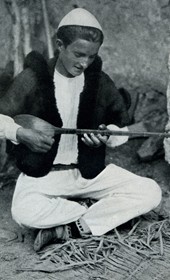
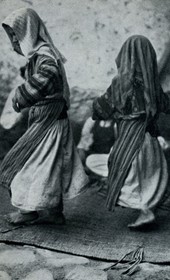

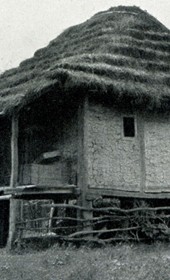


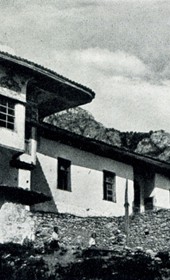


![HAB13: Church feast of Saint Anne [Shën Ana also called Shëne Prenna] in Kurbin, to which the peasants, including many Muslims, come far and wide to celebrate the name-day of Saint Anthony [Shën Ndou] (Photo: Hugo Bernatzik, 1929).](bernatzik_files/vlb_thumbnails1/hab13.jpg)
![HAB14: “Peasant woman at Saint Anne’s [Shën Ana] with a cradle on her back. The wooden cradle is covered with a veil to protect the child from the flies” (Photo: Hugo Bernatzik, 1929).](bernatzik_files/vlb_thumbnails1/hab14.jpg)



![HAB18: “Peasant woman in festive attire during mass at Saint Anne’s [Shën Ana]” in Kurbin (Photo: Hugo Bernatzik, 1929).](bernatzik_files/vlb_thumbnails1/hab18.jpg)
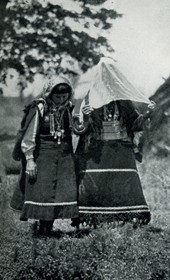
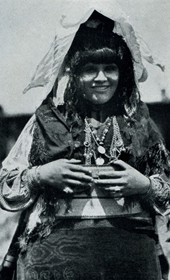
![HAB21: “Highland attire. Typical are long, tight-fitting, white woollen trousers with black braiding. The opankas [shoes] are made of old car tires” (Photo: Hugo Bernatzik, 1929).](bernatzik_files/vlb_thumbnails1/hab21.jpg)





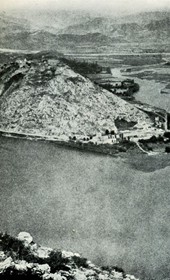
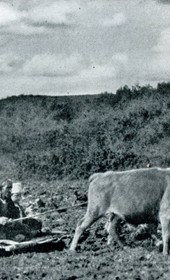
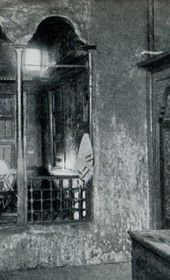
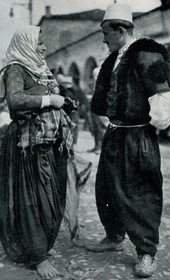
![HAB31: “Old Church of Saint Blasius [Shën Vllash or Shënavlash]” near Durrës (Photo: Hugo Bernatzik, 1929).](bernatzik_files/vlb_thumbnails1/hab31.jpg)
![HAB32: “Interior of the Church of Saint Blasius [Shën Vllash or Shënavlash]” near Durrës (Photo: Hugo Bernatzik, 1929).](bernatzik_files/vlb_thumbnails1/hab32.jpg)
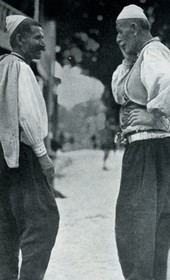
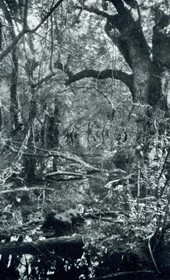
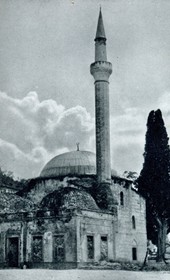
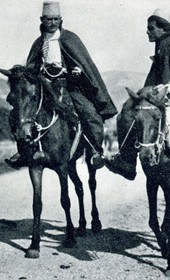


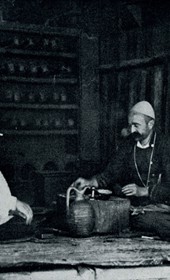

![HAB41: “View from the bridge over the Osum River near Berat. In the background are curious land formations on Maja e Shpiragut [Mount Shpirag]” (Photo: Hugo Bernatzik, 1929).](bernatzik_files/vlb_thumbnails1/hab41.jpg)
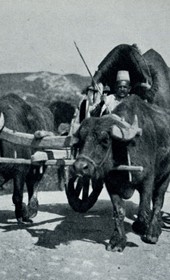

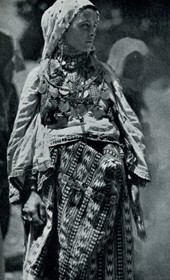
![HAB45: “The Archimandrite of Albania leading the procession in Shijon. Behind him is the coffin with the bones of Saint John [Saint John Vladimir]. The crowds endeavour to touch the relics” (Photo: Hugo Bernatzik, 1929).](bernatzik_files/vlb_thumbnails1/hab45.jpg)
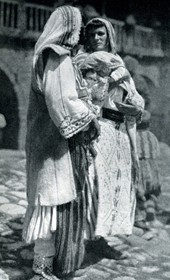
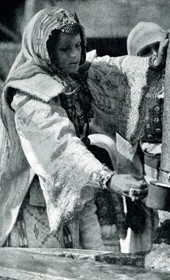
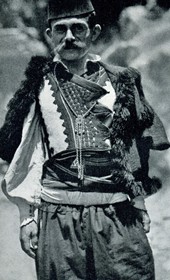


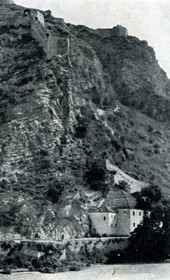
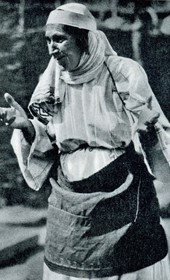
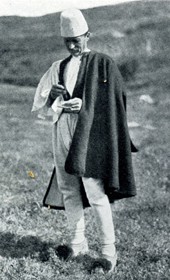
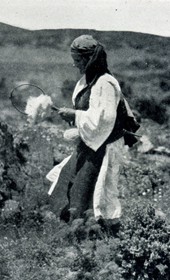



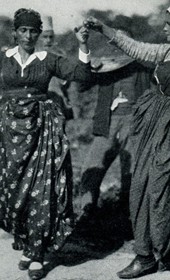


![HAB61: “Campsite of Aromanian [Vlach] nomads near Dardha” (Photo: Hugo Bernatzik, 1929).](bernatzik_files/vlb_thumbnails1/hab61.jpg)


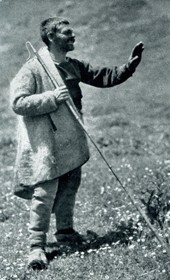
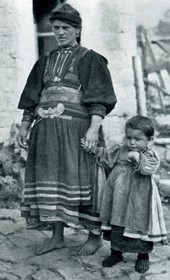
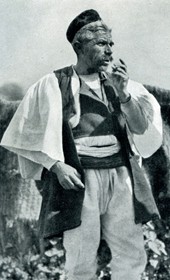
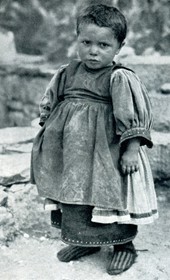
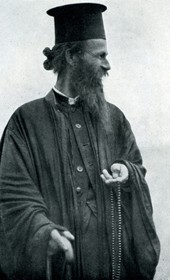
![HAB69: “Church [of St Nicholas] in Voskopoja, looted during the First World War” (Photo: Hugo Bernatzik, 1929).](bernatzik_files/vlb_thumbnails1/hab69.jpg)
![HAB70: “Village of Pustec. Bulgarian [i.e. Macedonian Slav] enclave on Lake Prespa” (Photo: Hugo Bernatzik, 1929).](bernatzik_files/vlb_thumbnails1/hab70.jpg)
![HAB71: “Bulgarian [i.e. Macedonian Slav] women at the weekly market in Korça” (Photo: Hugo Bernatzik, 1929).](bernatzik_files/vlb_thumbnails1/hab71.jpg)
![HAB72: “Bulgarian [i.e. Macedonian Slav] woman sowing corn behind a wooden plough” (Photo: Hugo Bernatzik, 1929).](bernatzik_files/vlb_thumbnails1/hab72.jpg)
![HAB73: “Bulgarian [i.e. Macedonian Slav] shepherd” (Photo: Hugo Bernatzik, 1929).](bernatzik_files/vlb_thumbnails1/hab73.jpg)
![HAB74: “Bulgarian [i.e. Macedonian Slav] fishermen on Lake Ohrid. Most of them do not know how to swim” (Photo: Hugo Bernatzik, 1929).](bernatzik_files/vlb_thumbnails1/hab74.jpg)

